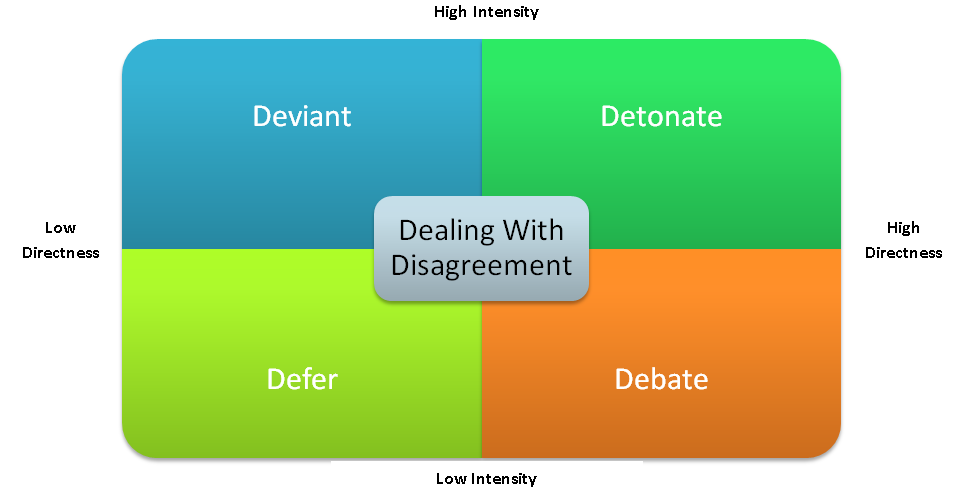Working with others means that you’ll eventually face conflict and disagreement.
Conflict isn’t bad: we need work cultures that support differing perspectives, multiple opinions, and divergent thinking. However, how we communicate our disagreements can either help or hinder our workplace relationships and results.A new paper in the Academy of Management Review identifies four distinct categories of conflict expression: how you deal with disagreements. The authors explain how effective (or not) each of these four styles are in the workplace.
The categories are based on two criteria:
-
Directness (How honest and straightforward are you in your expression of conflict?)
-
Intensity (How intense are you in your expression of conflict?)

matrix complete v2
Plotted on a matrix, the categories look like this. (I created category names for simplicity.) Here are some descriptions. We’ll start in the Upper Right, and work counter-clockwise.
High Directness/High Intensity (The Detonate Zone)The Detonate Zone is what most people think of when they think of conflict:
-
The Screamer.
-
The scoffer.
-
The finger-jabber.
Detonate Zone throws fuel on the fire of conflict. It shocks people into fight/flight mode on high alert.
If this is the zone that you think of when you think of “conflict”, it’s no wonder you avoid conflict. It goes without saying that Detonate Zone is destructive in the workplace: if you use this style, you could destroy a relationship with your detonate-ee.
Low Directness/High Intensity (The Deviant Zone)
While people tend to think of the Detonate Zone as “classic conflict”, the Deviant Zone is where conflict goes to breed in the dark corners and shadows of organizations.You won’t see Deviant Zone behavior out on the surface, but you’ll find it lurking all over:
-
Triangulation.
-
Gossip.
-
CC’d & BCC’d emails.
-
Us vs. Them.
-
Silos.
-
Turf Wars.
This is the zone of office politics at its worst You’ll find people holding grudges for years when they’re in the Deviant Zone. Like the Detonate Zone, not a productive place to work through disagreements.
Low Directness/Low Intensity (The Defer Zone)
The Defer Zone may seem mild, but its passive-aggressive nature can do serious damage. It’s a place of low ownership, where people minimize, rationalize and ignore issues. Some examples:
You have a time-sensitive matter that needs immediate attention.The response: Oops. I didn’t see that email.There is a critical piece of information that would keep your project from going off the rails.In the Defer Zone: Sharing information is not my job. This is the zone of where communication stays purposefully vague. (After all, if my meaning is clouded in a shroud of ambiguity, you can’t later hold me accountable for anything. I can always say that wasn’t my understanding: I never committed to what you said I did.)The Defer Zone is the zone of slipperiness.
High Directness/Low Intensity (The Debate Zone)
You’ve probably guessed it: the Debate Zone is the most productive place to deal with disagreement.
In the Debate Zone, you name the “elephant in the room”. This takes courage.The real challenge of the Debate Zone is to deal with uncomfortable issues while continually working to defuse potential emotional triggers. The Debate Zone works because you don’t trigger a high intensity response in yourself or the other person. Neither of you go into fight of flight.
In this zone, your mental capacities are freed up to resolve differences and create solutions where they didn’t exist.
Detonate, Deviant, Defer & Debate: Which zone do you see most workplace disagreements falling into? Join the conversation by leaving a comment below.
